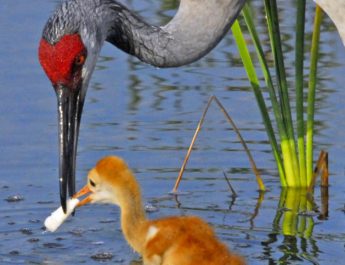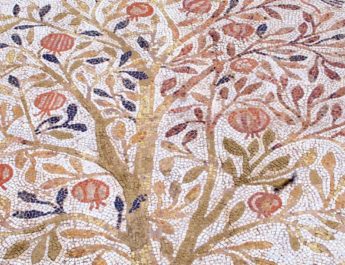Leviticus 12:1-8
A Women’s Lectionary – Presentation of the Lord
1 The LordA spokeB to Moses,C saying: 2 Speak to the peopleD of Israel,E saying:
A “Lord” = YHVH. From havah (to be, become) or hayah (to come to pass, become, be). This is the name of the God of Israel, the self-existent and eternal one, the tetragrammaton. This pronunciation has been lost to time so “Lord” is generally used in its place.
B “spoke” = dabar. This is generally to speak, answer, declare, or command. It might mean to arrange and so to speak in a figurative sense as arranging words.
C “Moses” = Mosheh. From mashah (to pull out in a literal or figurative sense, to draw out) OR from Egyptian mes or mesu (child, son i.e. child of…). This is Moses – the one drawn out from the water, which is to say, rescued. If derived from the Egyptian, his name would share a root with Rameses and Thutmose.
D “people” = ben. From banah (to build or obtain children). This is son, age, child. It is son in a literal or figurative sense.
E “Israel” = Yisrael. From sarah (to persist, exert oneself, contend, persevere, wrestle, prevail) + el (God or god). This is Israel, meaning God strives or one who strives with God; new name for Jacob and for his offspring. This refers to the people and to the land.
If a womanF conceivesG and bearsH a male child,I
F “woman” = ishshah. From ish (man); perhaps from enosh (human, humankind, mortal); from anash (to be weak, sick, or frail). This is woman, wife, or female.
G “conceives” = zara. This is to sow or scatter seed, conceive or yield. It can also refer to a sower. Figuratively, this can refer to other forms of dissemination.
H “bears” = yalad. This is to bear or bring forth. It can mean to act as midwife or to show one’s lineage. This is often used for birth or begetting.
I “male child” = zakar. From zakar (to remember, to mark something so that it can be recalled, to be mindful of, to mention). This is male. Properly, perhaps, it means one who is remembered, which is to say a male.
she shall be ceremonially uncleanJ sevenK days;L as at the time of her menstruation,M she shall be unclean.
J “be ceremonially unclean” = tame. This is to defile, be unclean, pollute in a ritual or ethical sense.
K “seven” = sheba. This is seven or by sevenfold. It can also be used to imply a week or an indefinite number. Symbolically, this is the number of fullness, sacredness, perfection.
L “days” = yom. Root may mean being hot. This is the day in a literal or figurative sense. It can also mean birth, age, daylight, continually or other references to time.
M “time of her menstruation” = niddah + davah. Niddah is form nadad (to wave back and forth; figuratively, to flee, stray, flutter chase away, shake, or shrink; a fugitive). This is rejection, impurity, menstruation, idolatry, incest. Davah is 1x in OT. It means sick. It could also refer to menstruation.
3 On the eighthN day the fleshO of his foreskinP shall be circumcised.Q
N “eighth” = shemini. From the same as shemoneh (eight; can be figurative for surplus); perhaps from shamen (to shine, which implies being oily, growing fat); from shaman (to grow fat, shine, be oily). This is eighth or sheminith.
O “flesh” = basar. From basar (being a messenger, publish, carry preach; properly, this is being fresh, rosy or cheerful as one bearing news). This is flesh, the body, fat, skin, self, nakedness, humankind, or kin. It can also refer to private parts.
P “foreskin” = orlah. 16x in OT. Perhaps from arel (uncircumcised, unskilled, exposed, forbidden); from arel (to strip or expose, restrain; to remove in a literal or figurative sense). This is foreskin or uncircumcised. It can also mean forbidden.
Q “be circumcised” = mul. This is to cut off, cut in pieces, or destroy. It is used for to circumcise. It can also mean to blunt.
4 Her time of bloodR purificationS shall beT thirtyU-threeV days;
R “blood” = dam. Perhaps from damam (to cease, be or become mute, silent, still, cut off, hold peace, be astonished, die). This is blood, bloodshed, bloodguilt, lifeblood, and death. It is used for people and animals. More often blood from a wound or the blood of the innocent. Used figuratively for violence or for wine. Closely tied to life and death.
S “purification” = tahorah. 15x in OT. From tohar (clearness or brightness; ritual purity); form taher (bright, which implies being pure or clean; to purge, cleanse, or purify; clean in a ritual sense or a moral one (i.e. moral or holy)). This is cleansing, purification – ritual or moral.
T “be” = yashab. This is to sit and so to remain and so to dwell. It is sitting for any reason – as a judge, in order to ambush, or just sitting quietly. Causatively, this can mean settling or marrying. This can also mean continue, endure, or establish.
U “thirty” = sheloshim. From the same as shalosh (three, fork, triad). This is thirty or thirtieth.
V “three” = shalosh. Related to “thirty” in v4. See note R above.
she shall not touchW anyX holy thing,Y or comeZ into the sanctuary,AA until the days of her purification are completed.BB
W “touch” = naga. This is touch, reach, arrive, come near, strike. This is touching for any reason including sexual or violent.
X “any” = kol. From kalal (to complete). This is all or every.
Y “holy thing” = qodesh. This is set apart and so sacred. God is different from us and so God is holy/set apart. Things we dedicate to God’s service are set apart for God and so they, too, are holy, etc.
Z “come” = bo. This is to enter, come in, advance, fulfill, bring offerings, enter to worship, attack. It can also have a sexual connotation.
AA “sanctuary” = miqdash. Related to “holy thing” in v4. From the same as qodesh (see note Y above). This is a sacred place, sanctuary, holy place. It is something or somewhere that is consecrated, whether to God or to another.
BB “are completed” = male. This is fill, satisfy, replenish, accomplish, fulfill, confirm, or consecrate. It is fill in a literal or figurative sense.
5 If she bears a female child,CC she shall be unclean two weeks,DD as in her menstruation;EE her time of blood purification shall be sixtyFF-sixGG days.
CC “female child” = neqebah. From naqab (to pierce, bore holes, puncture; to make a hole more or less forcefully; also to curse or libel). This is female or woman from an anatom ical reference.
DD “two weeks” = shabua. Related to “seven” in v2. From sheba (see note K above). This is week or seven increment duration.
EE “menstruation” = niddah. Same as “time of menstruation” in v2. See note M above.
FF “sixty” = shishshim. From shesh (six; figuratively, a surplus since it is one more than the number of fingers on the hand). This is sixty.
GG “six” = shesh. Related to “sixty” in v5. See note FF above.
6 When the days of her purification are completed, whether for a sonHH or for a daughter,II she shall bringJJ to the priestKK at the entranceLL of the tentMM of meetingNN
HH “son” = ben. Same as “people” in v2. See note D above.
II “daughter” = bat. Related to “people” in v2. From ben (see note D above). This is daughter in a literal or figurative sense.
JJ “bring” = bo. Same as “come” in v4. See note Z above.
KK “priest” = kohen. This is literally the one who officiates i.e. the priest. This is where the Jewish last name “Cohen” (and its variants) comes from.
LL “entrance” = petach. From patach (to open wide in a literal or figurative sense, loosen, plow, carve). This is opening, door, gate, entrance.
MM “tent” = ohel. Perhaps from ahal (to shine, be clear). This is a tent, covering, home, or side pillar.
NN “meeting” = moed. From yaad (to appoint, assemble or gather selves, agree). This is a meeting, assembly, fixed time. It can be used for a festival or feast. It can also refer to a meeting place.
a lambOO in its firstPP yearQQ for a burnt offering,RR
OO “lamb” = kebes. Root may mean to dominate. This is a young male sheep – having just reached the age where it can butt other sheep.
PP “first” = ben. Same as “people” in v2. See note D above.
QQ “year” = shanah. From shana (to change, alter). This is a year, age, old. It can also mean yearly.
RR “burnt offering” = olah. From alah (to go up, climb, approach, bring; to be high or actively climb; can be literal or figurative). This is a step, stairs, or some kind of ascent. It is also used for whole burnt offerings, being the offering in which the whole things is burned and rises as smoke. Burnt offerings were the least common of the offerings: most were eaten, shared with the priest and the one bringing the offering.
and aSS pigeonTT or a turtledoveUU for a sin offering.VV 7 He shall offerWW it beforeXX the Lord,YY
SS {untranslated} = ben. Same as “people” in v2. See note D above.
TT “pigeon” = yonah. Perhaps from yayin (wine; root means to effervesce). This is a dove or pigeon. Used to refer to the exiles coming home, to describe sails of ships. Also used figuratively for mourning or as a description of beauty.
UU “turtledove” = tor. 14x in OT. This is a literal dove – it can also be a romantic term of affection.
VV “sin offering” = chatta’ah. From chata’ (to miss or go wrong and so to sin, bear the blame; it can also include the sense of forfeiting or lacking). This is sin itself as well as punishment for sin. It is sometimes used specifically to refer to sin that is habitual.
WW “offer” = qarab. This is to come near, offer, make ready, approach, take.
XX “before” = paneh. From panah (to turn, face, appear). This is face in a literal or figurative sense. It could be face, presence, anger, respect. It can also be used of God to indicate divine favor or presence.
YY “Lord” = YHVH. Related to “Lord” in v1. See note A above. It has the same meaning as “Lord” above, but with a different vowel pointing.
and make atonementZZ on her behalf; then she shall be cleanAAA from her flowBBB of blood. This is the lawCCC for her who bears a child, male or female.
ZZ “make atonement” = kaphar. This is to appease, cover, pacify, cancel, make atonement, placate. Specifically, it can mean to cover with bitumen.
AAA “be clean” = taher. Related to “purification” in v4. See note S above.
BBB “flow” = maqor. 18x in OT. From qur (to dig, destroy, wall up). This is a spring or fountain. Properly, it is a site that was dug and so it is used for a wellspring. It also refers to natural water sources. It can be used of tears, blood, female genitalia. Figuratively, it can be offspring, posterity, wisdom, or happiness.
CCC “law” = torah. From yarah (to throw, shoot, be stunned; to flow as water so figuratively to instruct or teach). This is law, instruction, teaching, or statute. It can also refer to the first five books of the Bible – the Torah.
8 If she cannotDDD affordEEE a sheep,FFF she shall takeGGG twoHHH turtledoves or twoIII pigeons, oneJJJ for a burnt offering and the other for a sin offering; and the priest shall make atonement on her behalf, and she shall be clean.
DDD “cannot” = day. This is enough, plenty, overflow, or ability.
EEE “afford” = matsa + yad. Matsa is to find, catch or acquire. It can also mean to come forth or appear. Figuratively, this can mean to meet or be together with. Yad is hand, ability, power. Hand in a literal sense, but also what one can do or the means by which one does it.
FFF “sheep” = seh. Perhaps from sha’ah (to make a loud noise or crash, devastate, rush). This is a lamb, sheep, or goat – a part of a flock.
GGG “take” = laqach. This is to take, accept, carry away, receive. It can also have the sense of take a wife or take in marriage.
HHH “two” = shenayim. From sheni (double, again, another, second); from shanah (to fold, repeat, double, alter, or disguise). This is two, both, second, couple.
III {untranslated} = ben. Same as “people” in v2. See note D above.
JJJ “one” = echad. Perhaps from achad (to unify, continue on a path; figuratively, to gather one’s thoughts). This is the number one, first, united. It can also be alone, altogether, a certain, a few.
Image credit: “Newborn in Hospital – Sri Lanka” by Simone D. McCourtie, 2009.




